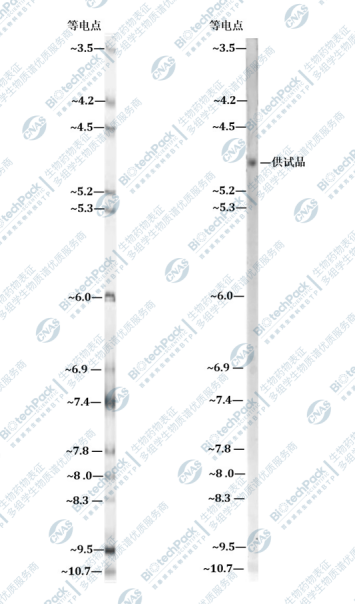Isoelectric Point Analysis Based on IEF
Protein molecules are amphoteric electrolytes. When the pH of the solution is adjusted so that the positive and negative charges on the protein molecule are equal, the protein molecule does not move towards the positive or negative electrode in an electric field. The pH value at this point is the isoelectric point (pI) of the protein. The isoelectric point of a protein is closely related to its amino acid sequence and three-dimensional structure. The isoelectric point of a specific protein is fixed, so by comparing the isoelectric points of different proteins, their structural and functional differences can be studied. Accurate determination of the isoelectric point is an important part of characterizing the charge heterogeneity of biological products.
Isoelectric Focusing (IEF) is a highly effective technique for analyzing protein isoelectric points. It takes advantage of the characteristic that proteins have zero charge at their isoelectric point. Charged proteins migrate in opposite directions during electrophoresis, and when they reach their isoelectric point (where the corresponding pH value causes the protein to no longer carry a charge), the current reaches a minimum and they stop moving. This allows for the detection of the isoelectric point of biological products. BTP through CNAS/ISO9001 dual quality certification system; the company has established a protein isoelectric point detection platform for different categories of biological products based on the principle of IEF, enabling precise determination of the isoelectric points of proteins, antibodies, vaccines, peptides, collagen, etc.
Experimental Instruments
- GE's Ettan IPGphor 3
Technical Applications
Isoelectric point analysis based on cIEF, the detector collects absorption peaks at 280nm. For biological products without absorption peaks at 280nm, such as collagen, the cIEF method is evidently less suitable. The method based on IEF is an effective supplement for detecting isoelectric points of proteins without absorption peaks at 280nm and is widely used in the characterization of collagen-based biological products and medical devices.
Case Illustration
During the experiment, one strip is used to test the Marker, calibrating the pI distribution of the pre-made strip, and another strip is used to test the sample; both strips undergo isoelectric focusing simultaneously to reduce system error.

The left shows the pI marker result, and the right shows the collagen sample result
Typical Q&A
Question1: Why is the isoelectric point of most proteins neutral to slightly acidic?
Answer:Proteins are composed of amino acids, and most amino acids have isoelectric points lower than the pH of the human body (pH=7.4), hence the isoelectric points of most proteins are slightly acidic, such as the isoelectric point of goat pepsin which is about 3.
Question2: Are there proteins with basic isoelectric points?
Answer:There are proteins with basic pI. When there is a higher proportion of basic amino acids in the protein, such as histidine, arginine, and lysine, the isoelectric point can be basic, such as the isoelectric point of protamine which is about 12.
Question3: How to choose between the two detection methods for isoelectric point testing?
Answer:Isoelectric point detection based on CIEF requires the sample to have UV absorption at 280nm; samples without UV absorption at 280nm (such as collagen) are tested using isoelectric point detection based on IEF.
Chinese/English Project Report
In the technical report, BTP will provide you with a detailed bilingual Chinese-English technical report, including:
1. Experimental Procedures (Chinese and English)
2. Relevant Experimental Parameters (Chinese and English)
3. Detailed information on protein isoelectric point analysis based on IEF
4. Electrophoresis Images
5. Raw Data
Protein Isoelectric Point Analysis Based on IEFOne-Stop Service
You only need to place an order - send samples
BTP's one-stop service completes: sample processing - on-machine analysis - data analysis - project report
Related Services
How to order?





